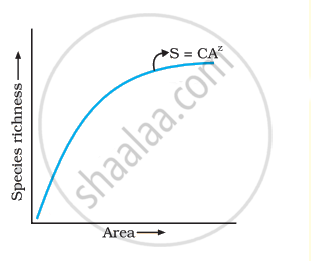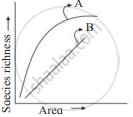Advertisements
Advertisements
Question
The relation between species richness and area for a wide variety of taxa turns out to be a rectangular hyperbola. Give a brief explanation.
Solution
During his pioneering and extensive explorations in the wilderness of South American jungles, the great German naturalist and geographer Alexander von Humboldt observed that within a region species richness increased with the increasing explored area, but only up to a limit. In fact, the relation between species richness and area for a wide variety of taxa (angiosperm plants, birds, bats, freshwater fishes) turns out to be a rectangular hyperbola.

Species area relationship
APPEARS IN
RELATED QUESTIONS
The following graph shows the species - area relationship. Answer the following questions as directed.

(a) Name the naturalist who studied the kind of relationship shown in the graph. Write the observations made by him.
(b) Write the situations as discovered by the ecologists when the value of 'Z'
(Slope of the line) lies between.
(i) 0.1 and 0.2
(ii) 0.6 and 1.2
What does 'Z' stand for?
(c) When would the slope of the line 'b' become steeper?
Observe the graph and select the correct option:

Which of the following hypothesis states: Rich species diversity leads to lesser variation in biomass production over a period of time.
Maximum species richness is observed in the ______.
In the equation: log S = log C + Z log A , S= species richness; Z = slope of line (regression coefficient); A = area; C = Y intercept. For smaller area, the value of Z ranges from ____________.
Oxygen dissociation curve for Myoglobin has the following shape:
Amongst the animal group given below, which one has the highest percentage of endangered species?
Which of the below mentioned regions exhibit lees seasonal variations?
What does the term ‘Frugivorous’ mean?
Which of the following hypothesis suggests that ecosystems are like aeroplanes where flight safety (ecosystem functioning) may or may not be compromised, depending upon which species are being lost?
